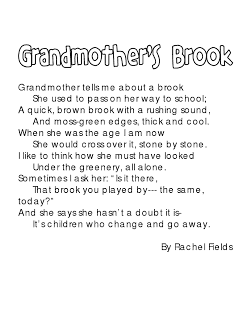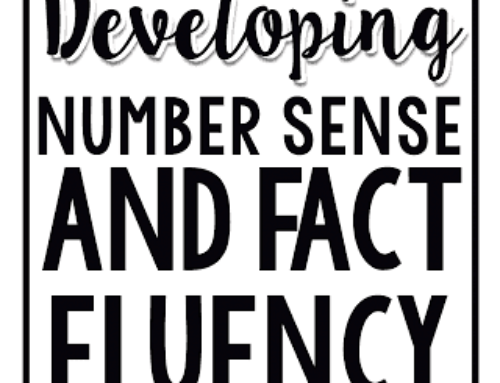Another one of my
favorite activities is to use poetry to teach visualization. Since I
teach this during testing, I try to add in some interesting hands on element to
the lesson.
favorite activities is to use poetry to teach visualization. Since I
teach this during testing, I try to add in some interesting hands on element to
the lesson.
I project this poem by Rachel
Fields.
Fields.
Grandmother’s
Brook
Brook
Grandmother tells me about a brook
She used to pass on her way to school;
A quick, brown brook with a rushing sound,
And moss-green edges, thick and cool.
When she was the age I am now
She would cross over it, stone by
stone.
stone.
I like to think how she must have looked
Under the greenery, all alone.
Sometimes I ask her: “Is it there,
That brook you played by— the same,
today?”
today?”
And she says she hasn’t a doubt it is-
It’s children who change and go away.
First I talk about how to make friends and
understand a poem. I read the poem two
times. Then I read it line by line and
talk about what I notice in the poem.
Some of the things we discuss are:
understand a poem. I read the poem two
times. Then I read it line by line and
talk about what I notice in the poem.
Some of the things we discuss are:
·
What is a brook? What would it look like or sound like? I have
students close their eyes and visualize.
What is a brook? What would it look like or sound like? I have
students close their eyes and visualize.
·
Who is the speaker? How do we know?
Who is the speaker? How do we know?
·
How old is the speaker?
How old is the speaker?
·
How did she cross the brook? What does stone-by stone mean? I have even
had kids act it out if they are especially antsy.
How did she cross the brook? What does stone-by stone mean? I have even
had kids act it out if they are especially antsy.
·
What is greenery? What would it look? I have students close
their eyes and visualize.
What is greenery? What would it look? I have students close
their eyes and visualize.
·
I have students close their eyes again and visualize
what the brook would look like now after all the information the speaker has
given us.
I have students close their eyes again and visualize
what the brook would look like now after all the information the speaker has
given us.
·
What is the purpose of the hyphen? Why would a pause be important in how it is
read?
What is the purpose of the hyphen? Why would a pause be important in how it is
read?
·
What does it mean when the Grandmother says, “It’s
the children who change and go away?”
What does it mean when the Grandmother says, “It’s
the children who change and go away?”
Students go back to their seats and use pencil to draw in the brook as the background of the poem. I have them use the entire page- even over the words. Students illustrate what they visualize when we read the poem. I encourage students to use the details that we learned from the poem. For example we know the color of the brook, the trees around it, there is a school house, the stones across the brook and so on.
Then I pull out the big guns. I give students water color paints and have them paint what they visualize. Once again, it is a great way too cool sown after a long say of testing and is still academic.
Mandy Gregory is a 2007 and 2012 Teacher of the Year. She has taught Kindergarten- 4th grades in both the general education and inclusion settings. She is currently a 1st grade Special Education teacher. She is the owner and creator of Mandy’s Tips for Teachers website (www.mandystipsforteachers.com) and has over 13 years of teaching experience. She is married with two beautiful children.







What a great lesson on visualization. I love it. You are right…perfect for after testing.
Elizabeth
Fun in Room 4B